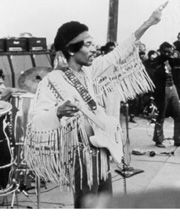POPULAR MUSIC SEETHES with a hidden power, intangible in the context of the time in which it’s created, but insidious in the way it permeates what follows. A handful of icons from the modern era—Bob Dylan, the Beatles, Elvis Presley, Miles Davis—influenced and continue to inspire not only musicians but all of Western culture. Their accomplishments can’t be downplayed, and history will probably bestow even more importance on them.
A Magic Science: Celebrating Jimi Hendrix
Benaroya Hall Sunday, November 26
Whether or not Jimi Hendrix will earn a place among these icons remains unclear. His contributions as a guitarist and performer leave no doubt: Among guitarists, only Les Paul and Andres Segovia mastered their respected fields as convincingly; on stage, Hendrix’s mind-blowing, literally incendiary work furthered the devilish example set by Jerry Lee Lewis. But as a songwriter and personality, Hendrix’s individuality and elusiveness—not to mention his race—have made him a harder sell.
Still, it’s worth exploring this fascinating figure, who would have turned 58 this week (he passed away in 1970 at age 27, making this year the 30th anniversary of his death). It’s fortuitous timing then for Experience Music Project—a museum catalyzed by Paul Allen’s love of Hendrix’s music—to launch its Innovators series with a week of performances, panel discussions, and films devoted to the guitarist’s legacy.
A KIND OF PALLOR HANGS alongside the memory of the musical greats who died too young, especially Janis Joplin, Kurt Cobain, Tupac Shakur, and Hendrix. The sadness springs from thinking about what they’d have gone on to do. In Hendrix’s case, such thoughts are especially bittersweet, given that the guitarist’s already considerable range, which spanned funk and hard rock, began tilting in an intriguing direction toward jazz. Besides informally collaborating with Miles Davis, Hendrix scheduled a recording session with jazz great Gil Evans during the summer of 1970 but died before their first encounter. Deprived of the chance to work with him, Evans transcribed existing Hendrix songs and presented them with his orchestra at a 1974 Carnegie Hall performance. The historic moment faded from memory until this year, when Brooklyn Academy of Music curator Danny Kapilian and his friend, guitarist Vernon Reid, set about planning a Hendrix memorial concert.
“Vernon and I had many discussions,” Kapilian recalls on the phone from New York, a Dylan song blaring in the background. “We wanted to tie it in with the most-asked question in rock: What if Hendrix had lived?”
Another musician friend, Al Kooper, later told Kapilian about the Evans concert and of a rare recording of it. “I went to the record store and found a copy that day,” Kapilian says. “I took it home, put it on, and was knocked out by it.”
Kapilian had his answer. He phoned Miles Evans, Gil’s son and leader of the Gil Evans Orchestra, and the seeds for “A Magic Science: Celebrating Jimi Hendrix” were planted. Soon, Kapilian and Reid had signed up the Evans Orchestra, the band Medeski Martin & Wood and their associate DJ Logic, vocalists Marc Anthony Thompson and Sandra St. Victor, as well as other New York musicians and ’60s psychedelic light show veteran Glenn McKay, for a grand-scale reinterpretation of Gil Evans’ Hendrix makeover. The premiere took place in October at New York’s Avery Fisher Hall and will be restaged for only the second time at Benaroya Hall Sunday, November 26, to kick off EMP’s Hendrix week.
But despite its placement at the head of the Innovators series, Kapilian, who’s producing the Seattle performance, insists that the show’s meant to broaden Hendrix’s role in the current music landscape, not memorialize it. “It’s a mistake to view this as a relic,” he notes. “The fact that it’s related to a museum doesn’t make it historic.”
FOR A HISTORICAL perspective, Hendrix fans and budding musicologists may wish to attend the programs slated to appear during the week at EMP, and they’ll have Bob Santelli to thank. The deputy director of public programming, Santelli came to EMP via Cleveland’s Rock ‘n’ Roll Hall of Fame, where he instituted similarly inspired series; Cleveland newspapers lamented his move to Seattle in June. He’s clearly excited by the possibilities presented in his first few months on the job, and he says that the Innovators series developed from his desire to unite the various departments, from the curatorial to the technological, within EMP.
“There are more resources here than I had at the Rock ‘n’ Roll Hall of Fame, so things will be more dynamic,” he says.
The week’s events support his theory. Monday night, EMP screens the film Blue Wild Angel: Jimi Hendrix at the Isle of Wight in its Seattle debut; a discussion with filmmaker Murray Lerner follows (JBL Theater, 7pm, $5 members/$7 public). Tuesday, senior curators Pete Blecha and Jim Fricke revisit the making of EMP’s Jimi Hendrix Gallery (JBL Theater, 7pm, free). The series skips a night Wednesday, then resumes Thursday with two films, The Making of Electric Ladyland and Band of Gypsies—Live at the Fillmore East (JBL Theater, 7pm, free), and continues Friday with a presentation by Hendrix producer Eddie Kramer (JBL Theater, 7pm, $5). Saturday brings a full plate of panel discussions and conversations at EMP ($8 members/$10 public), then concludes with a show featuring Kenny Wayne Shepherd, Tommy Shannon, Chris Layton, Wayne Kramer, Reeves Gabrels, Mike McCready, and more (Showbox, 7:30pm, $10 members/$12 public). They’ll close out the week celebrating Hendrix as innovator, while opening the book on whether he’ll secure a permanent place in the pantheon of rock icons.






